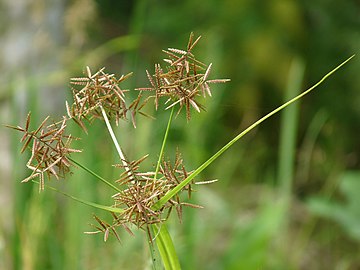Cyperaceae
| Cyperaceae | |
|---|---|

| |
| Cyperus polystachyos flower head | |
| Scientific classification | |
| Kingdom: | Plantae |
| Clade: | Tracheophytes |
| Clade: | Angiosperms |
| Clade: | Monocots |
| Clade: | Commelinids |
| Order: | Poales |
| Family: | Cyperaceae Juss.[1] |
| Genera | |
|
94, see text[2] | |
The Cyperaceae (/ˌsaɪpəˈreɪsi.iː, -ˌaɪ/) are a family of graminoid (grass-like), monocotyledonous flowering plants known as sedges. The family is large; botanists have described some 5,500 known species in about 90 genera[3][4] – the largest being the "true sedges" (genus Carex),[5][6] with over 2,000 species.[7]
Distribution
Cyperaceae species are widely distributed, with the centers of diversity for the group occurring in
Classification
Some species superficially resemble the closely related
Some well-known sedges include the water chestnut (Eleocharis dulcis) and the papyrus sedge (Cyperus papyrus), from which the writing material papyrus was made. This family also includes cotton-grass (Eriophorum), spike-rush (Eleocharis), sawgrass (Cladium), nutsedge or nutgrass (Cyperus rotundus, a common lawn weed), and white star sedge (Rhynchospora colorata).
Features
Members of this family are characterised by the formation of dauciform (carrot-like) roots; an alteration in root morphology that researchers regard as analogous to cluster roots in Proteaceae, which help uptake of nutrients such as phosphorus from poor soil.[11] Like other members of the order Poales, sedges are mostly wind-pollinated, but there are exceptions. Cyperus obtusiflorus and Cyperus sphaerocephalus, both with accordingly more conspicuous flowers, are insect-pollinated.[12]
Evolution
This section needs expansion. You can help by adding to it. (February 2024) |
Researchers have identified sedges occurring at least as early as the Eocene epoch.[13]
Genera
As of 2024[update], 94 genera are accepted in Kew's Plants of the World Online:[2]
- Abildgaardia Vahl
- Actinoschoenus Benth.
- Actinoscirpus (Ohwi) R.W.Haines & Lye
- Afroscirpoides García-Madr. & Muasya
- Afrotrilepis (Gilly) J.Raynal
- Ammothryon R.L.Barrett, K.L.Wilson & J.J.Bruhl
- Amphiscirpus Oteng-Yeb.
- Anthelepis R.L.Barrett, K.L.Wilson & J.J.Bruhl
- Arthrostylis R.Br.
- Becquerelia Brongn.
- Bisboeckelera Kuntze
- Blysmus Panz. ex Schult.
- × Bolboschoenoplectus Tatanov
- Bolboschoenus (Asch.) Palla
- Bulbostylis Kunth
- Calliscirpus C.N.Gilmour, J.R.Starr & Naczi
- Calyptrocarya Nees
- Capeobolus Browning
- Capitularina J.Kern
- Carex L.
- Carpha Banks & Sol. ex R.Br.
- Caustis R.Br.
- Cephalocarpus Nees
- Chamaedendron (Kük.) Larridon
- Chorizandra R.Br.
- Chrysitrix L.
- Cladium P.Browne
- Coleochloa Gilly
- Costularia C.B.Clarke
- Cryptangium Schrad. ex Nees
- Cyathochaeta Nees
- Cyathocoma Nees
- Cyperus L.
- Diplacrum R.Br.
- Diplasia Pers.
- Dracoscirpoides Muasya
- DulichiumPers.
- Eleocharis R.Br.
- Eriophorum L.
- Erioscirpus Palla
- Evandra R.Br.
- Everardia Ridl.
- Exocarya Benth.
- Exochogyne C.B.Clarke
- Ficinia Schrad.
- Fimbristylis Vahl
- Fuirena Rottb.
- Gahnia J.R.Forst. & G.Forst.
- Gymnoschoenus Nees
- Hellmuthia Steud.
- Hypolytrum Pers.
- Isolepis R.Br.
- Khaosokia D.A.Simpson, Chayam. & J.Parn.
- Koyamaea W.W.Thomas & G.Davidse
- Krenakia S.M.Costa
- Lagenocarpus Nees
- Lepidosperma Labill.
- Lepironia Pers.
- Machaerina Vahl
- Mapania Aubl.
- Mesomelaena Nees
- Microdracoides Hua
- Morelotia Gaudich.
- Neesenbeckia Levyns
- Nelmesia Van der Veken
- Netrostylis R.L.Barrett, J.J.Bruhl & K.L.Wilson
- Oreobolus R.Br.
- Paramapania Uittien
- Phylloscirpus C.B.Clarke
- Principina Uittien
- Pseudoschoenus (C.B.Clarke) Oteng-Yeb.
- Ptilothrix K.L.Wilson
- Reedia F.Muell.
- Rhodoscirpus Léveillé-Bourret, Donadío & J.R.Starr
- Rhynchocladium T.Koyama
- Rhynchospora Vahl
- Schoenoplectiella Lye
- Schoenoplectus (Rchb.) Palla
- Schoenus L.
- Scirpodendron Zipp. ex Kurz
- Scirpoides Ség.
- Scirpus Tourn. ex L.
- Scleria P.J.Bergius
- Scleroschoenus K.L.Wilson, J.J.Bruhl & R.L.Barrett
- Sumatroscirpus Oteng-Yeb.
- Tetraria P.Beauv.
- Trachystylis S.T.Blake
- Trianoptiles Fenzl ex Endl.
- Trichophorum Pers.
- Trichoschoenus J.Raynal
- Tricostularia Nees
- Trilepis Nees
- Xyroschoenus Larridon
- Zameioscirpus Dhooge & Goetgh.
- Zulustylis Muasya
-
Cyperus brevifolioides (Kyllinga gracillima)
References
- hdl:10654/18083.
- ^ a b "Cyperaceae". Plants of the World Online. Royal Botanic Gardens, Kew. Archived from the original on 27 February 2020. Retrieved 11 February 2024.
- from the original on 29 July 2016. Retrieved 14 July 2016.
- ISBN 978-1-84246-199-0.
- ^ "sedge family". Merriam-Webster. Archived from the original on 26 December 2013. Retrieved 25 December 2013.
- ^ Milne, Lorus Johnson; Milne, Margery Joan Greene (1975). Living plants of the world. Random House. p. 301.
- S2CID 19514206.
- ^ "Grasslike non-grasses". Backyard Nature. Archived from the original on 5 March 2009. Retrieved 30 December 2014.
- ^ Ball, Peter W.; Reznicek, A. A.; Murray, David F. (2002). "Cyperaceae". In Flora of North America Editorial Committee (ed.). Flora of North America North of Mexico (FNA). Vol. 23. New York and Oxford: Oxford University Press – via eFloras.org, Missouri Botanical Garden, St. Louis, MO & Harvard University Herbaria, Cambridge, MA.
- ^ Brian R. Speer (29 September 1995). "Glumiflorae: More on Morphology". University of California, Berkeley. Archived from the original on 6 May 2009. Retrieved 23 March 2007.
- ^
Shane, Michael W.; Cawthray, Gregory R.; Cramer, Michael D.; Kuo, John; Lambers, Hans (2006). "Specialized 'dauciform' roots of Cyperaceae are structurally distinct, but functionally analogous with 'cluster' roots". Plant, Cell & Environment. 29 (10): 1989–1999. PMID 16930324.
- PMID 21585389.
- ^
Shribbs, John (2021). "Sedges in our wetlands". Petaluma Wetlands Alliance. Retrieved 21 February 2024.
Fossil sedges are known from as early as the Eocene 56 to 33.9 million years ago (mya) and modern sedges are very similar to ancient fossils.




